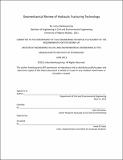Geomechanical review of hydraulic fracturing technology
Author(s)
Arop, Julius Bankong
DownloadFull printable version (13.00Mb)
Other Contributors
Massachusetts Institute of Technology. Department of Civil and Environmental Engineering.
Advisor
John Germaine.
Terms of use
Metadata
Show full item recordAbstract
Hydraulic fracturing as a method for recovering unconventional shale gas has been around for several decades. Significant research and improvement in field methods have been documented in literature on the subject. The heterogeneous nature of shale has made hydraulic fracturing design to be unique for particular site conditions. Actual methods of carrying out fracturing operations and design decisions are also different for various companies in the industry. Hence, there are no standards for decisions in processes such as: formation testing, fracture modeling, choice of fracturing fluid or propping agent selection. This has led to different interpretations of pressure tests and proprietary fracture designs that have not been evaluated for adequacy against any recognized scale. The goal of this thesis is to do an appraisal of hydraulic fracturing in theory and practice. A review is done of the early theoretical work upon which most of the current hydraulic fracturing literature is based. Effort is also made to thoroughly cover the core aspects of fracture modeling and practical operations with a view to shedding light on the strength and drawbacks of current methodologies. The thesis focuses on the geo-mechanics of the process thus less emphasis is laid on post fracturing operations. It is hoped that this will help establish the basis for a standard framework to guide fracturing design. Finally, the ambiguity of nomenclature in oil and gas circles has led to considerable confusion in conducting academic work. For this reason, effort was made in the thesis to clearly define the various terminology.
Description
Thesis (M. Eng.)--Massachusetts Institute of Technology, Dept. of Civil and Environmental Engineering, 2013. This electronic version was submitted by the student author. The certified thesis is available in the Institute Archives and Special Collections. Cataloged from student-submitted PDF version of thesis. Includes bibliographical references (p. 283-291).
Date issued
2013Department
Massachusetts Institute of Technology. Department of Civil and Environmental EngineeringPublisher
Massachusetts Institute of Technology
Keywords
Civil and Environmental Engineering.